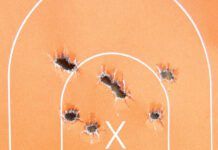For more than a year, we have been testing and evaluating some of the most powerful and interesting self-loading handgun cartridges. These are the ubiquitous 9mm Luger, which we think has become the baseline against which all other handgun chamberings can be compared, and the far-less-common but still commercially viable 38 Super, 357 SIG, and 357 Magnum, the last of which is chambered in a Coonan handgun. The evaluation was the result of a reader request, and three of which, the 9mm, 38 Super, and 357 SIG, sometimes use the same bullets, but at different velocities.
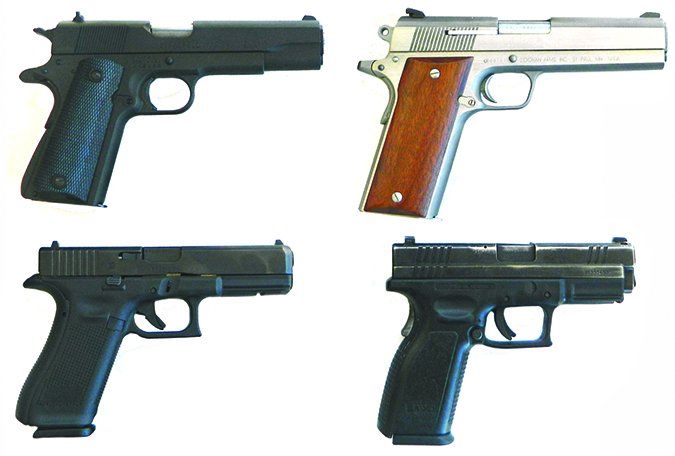
We began with a number of goals. First, as always, reliability has to be foremost because the handguns were competing as personal-defense choices. We also viewed them as outdoors-carry choices for defense against feral dogs and big cats. We wanted to see how efficiently each cartridge delivered its power, with the idea that the 9mm set the floor.
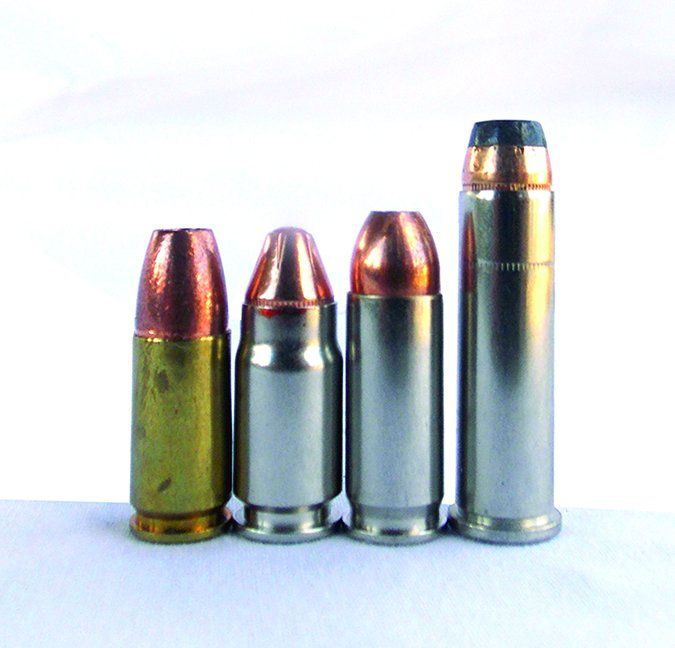
Increased flash, blast, and recoil may be counterproductive in the others, and as it turned out, we got more horsepower with less recoil than expected. The energy difference wasn’t incremental; it was profound. We didn’t choose average 9mm or 38 Super loads, but instead picked those loads that had given good results in the past. Only the top performers in 9mm and 38 Super are in this report. With the 357 SIG and 357 Magnum, we were on new ground and chose a representative sample of bullet weights.
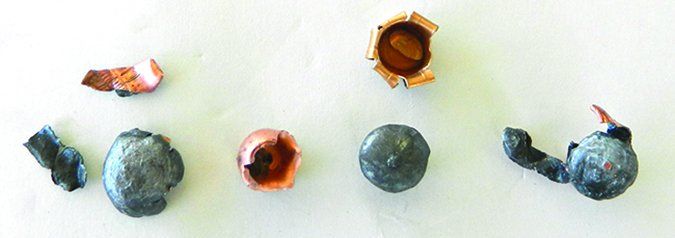
The 357 SIG and 357 Magnum enjoy an excellent reputation for terminal ballistics. The 9mm, less so, and based on previous data, we expected the 38 Super to be as effective or more than a 9mm Luger +P+ load. The primary consideration was personal defense, so control was important. The larger guns may not be ideal for concealed carry, but would be good handguns for field use or home defense.
For those wishing to deploy a handgun with plenty of power and accuracy, the 357-caliber self-loaders are easier to control than Magnum revolvers. The self-loaders demonstrate less recoil due to the smaller charge of faster-burning powder and the movement of the action and compression of springs as the handgun is fired. So how would they compare to the revolver? As it turned out, these modern powerhouses outclass the 357 Magnum revolver, in our opinion, on many levels.
Performance Data
| Glock Model 17 Gen5 9mm Luger | Average velocity (fps) | Muzzle energy (ft.-lbs.) | Power Factor (pf) | Average Accuracy (in.) | Expanded Width (in.) | Retained Weight (gr.) | Penetration in Water (in.) |
| 9mm 115-gr. DoubleTap JHP | 1340 | 458 | 154 | 3 | 0.83 | 113/98% | 16 |
| 9mm 124-gr. Federal HST | 1185 | 387 | 147 | 2.6 | 0.72 | 123/99% | 14 |
| 9mm 124-gr. Hornady AG +P | 1199 | 396 | 149 | 2.5 | 0.66 | 124/100% | 17 |
| 9mm 124-gr. Winchester PDX +P | 1214 | 406 | 151 | 2.6 | 0.65 | 124/100% | 16 |
| Springfield Armory XD-357 357 SIG | |||||||
| 357 SIG 115-gr. DoubleTap JHP | 1516 | 587 | 174 | 3 | 0.82 | 115/100% | 18 |
| 357 SIG 125-gr. DoubleTap JHP | 1458 | 590 | 182 | 2.8 | Frag | 90/72% | 12 |
| 357 SIG 125-gr. Winchester SXT | 1360 | 513 | 170 | 2.9 | 0.67 | 125/100% | 18 |
| 357 147-gr. Hornady XTP | 1198 | 468 | 176 | 2.5 | 0.56 | 147/100% | 24 |
| Springfield Armory 1991 Mil-Spec 38 Super | |||||||
| 38 Super 115-gr. DoubleTap JHP | 1419 | 514 | 163 | 2.3 | 0.84 | 112/97% | 18 |
| 38 Super 115-gr. Buffalo Bore JHP | 1421 | 515 | 163 | 2 | 0.55 | 112/97% | 18 |
| 38 Super 125-gr. DoubleTap JHP | 1402 | 545 | 175 | 2.5 | 0.81 | 123/98% | 16 |
| 38 Super 147-gr. Buffalo Bore JHP | 1099 | 394 | 162 | 2.4 | 0.54 | 147/100% | 24 |
| Coonan Classic 1911 357 Magnum | |||||||
| 357 Mag 125-gr. Federal JHP | 1570 | 684 | 196 | 1.5 | Frag | 56/45% | 12 |
| 357 Mag 140-gr. Federal Barnes | 1448 | 652 | 203 | 1.6 | 0.40 | 140/100% | 28 |
| 357 Mag 158-gr. Federal Hydra-Shok | 1404 | 691 | 222 | 1.5 | 0.42 | 122/77% | 30 |
| 357 Mag 158-gr. DoubleTap Bonded | 1412 | 699 | 223 | 1.6 | 0.50 | 158/100% | 28 |
| Notes: Average Velocity and standard deviation readings were obtained by firing four five-shot strings over a Competition Electronics Pro Chrono. Ambient temperature: 86 degrees. Elevation: 815 feet above sea level. l The accuracy figures are the average of two five-shot groups. For accuracy, we fired the test gun from a benchrest at a 25-yard target. l To calculate IPSC power factor, multiply bullet weight in grains by the velocity in fps, then divide by 1000. l The retained-weight column shows the recovered bullet weight and the resulting percentage of the starting bullet weight. | |||||||
| Ammunition sources: DoubleTap 9mm Luger +P 115-grain Bonded Defense JHP ($29/20 rounds at CheaperThanDirt.com), Federal 9mm Luger 124-grain HST ($23.97/50 at AmmunitionDepot.com), Hornady 9mm Luger 124-grain +P American Gunner ($18.21/25 at CheaperThanDirt.com), and Winchester 9mm Luger 124-grain PDX +P ($21.49/20 at MidwayUSA.com). DoubleTap 357 SIG 115-grain JHP ($27.38/20 from CheaperThanDirt.com), DoubleTap 357 SIG 125-grain ($27.38/20 CheaperThanDirt.com), Winchester 357 SIG 125-grain SXT ($21.95/20 at AmmoToGo.com), and Hornady 357 SIG 147-grain XTP ($20/20 from SportsmansGuide.com). DoubleTap 38 Super 115-grain JHP ($25.42/20 from DoubleTapAmmo.net), Buffalo Bore 38 Super 115-grain JHP ($28.79/20 from BuffaloBore.com), DoubleTap 38 Super 125-grain bonded JHPs ($25.42/20, DoubleTapAmmo.net), Buffalo Bore 38 Super 147-grain JHP ($29.80/20 from BuffaloBore.com). Federal 357 Magnum 125-grain JHP ($24.72/ 20 from CheaperThanDirt.com), Federal 357 Magnum 140-grain Barnes ($30/20 rounds at LuckyGunner.com), Federal 357 Magnum 158-grain Hydra-Shok ($13/20 at TargetSportsUSA.com), and DoubleTap 357 Magnum 158-grain Bonded Core ($23.74/20 at DoubleTapAmmo.net). | |||||||
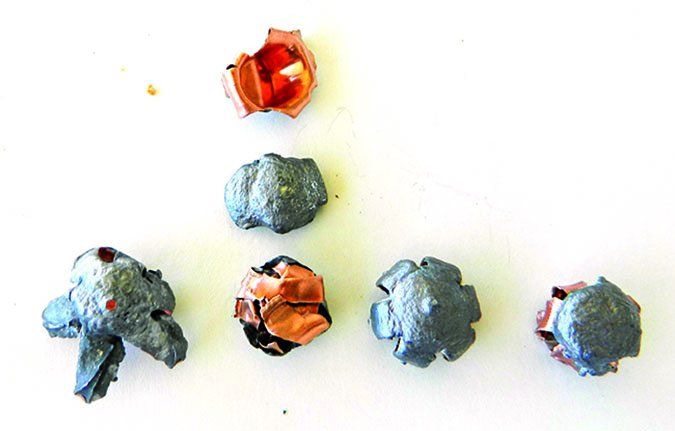
We collected a good supply of ammunition, five loads for each gun versus our usual three. We chose three powerful hollowpoint loads for accuracy testing, as is SOP for Gun Tests. We added a fourth load for ballistic testing to test penetration and expansion. We added an economical practice load for use in the combat-firing test phase. So, this was a thorough test requiring several months. We elected not to go lighter than 115-grain bullets in any chambering. The 357 SIG, 38 Super, and 9mm Luger are usually loaded with bullets in the range of 115 to 147 grains. We fired 125-, 140-, and 158-grain bullets in the 357 Magnum Coonan. Here are the results:
Glock 17 Gen5 9mm Luger, $545
GUN TESTS GRADE: B
The Glock 17 Generation 5 is a credible firearm, but the sum of its parts is not a great leap forward over previous handguns, in our view. We like the new Marksman barrel and the ambi safety. In this shoot out, the Glock 17 suffered when its power and accuracy were compared to the other handguns. We have recently tested the Glock 17 Vickers Tactical and liked it better.
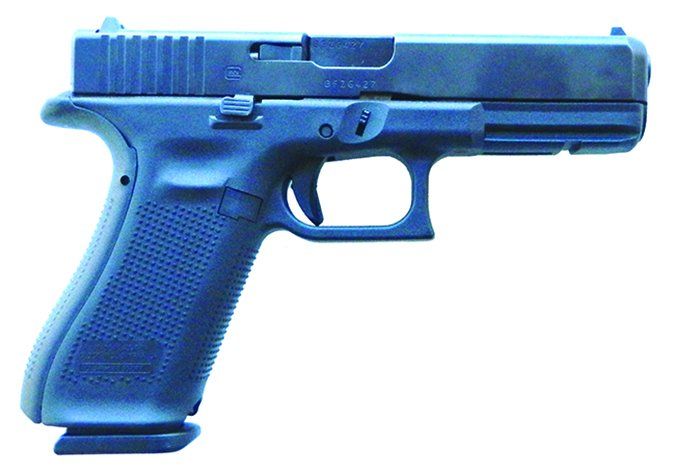
| ACTION | Safe Action/DAO |
| OVERALL LENGTH | 8.1 in. |
| OVERALL HEIGHT | 5.5 in. |
| MAX WIDTH | 1.34 in. |
| WEIGHT UNLOADED | 25 oz. |
| WEIGHT LOADED | 32.1 oz. |
| BARREL | 4.49 in. long, Marksman style steel; RH hexagonal twist 1:9.84 in. |
| MAGAZINE | 17-rd. detachable box |
| SLIDE | Steel; nDLC finish |
| SLIDE-RACKING FORCE | 10.5 lbs. |
| FRAME | Polymer; ambi slide-stop levers; flared magwell |
| FRAME FRONT STRAP HEIGHT | 2.5 in., no grooves |
| FRAME BACK STRAP HEIGHT | 3.5 in. |
| GRIPS | N/A |
| GRIP THICKNESS (max) | 1.2 in. |
| GRIP CIRCUMFERENCE (max) | 6.2 in. |
| FRONT SIGHT | White dot on steel post; 6.5 in. sight radius |
| REAR SIGHT | Standard white outline |
| TRIGGER PULL WEIGHT | 5.5 lbs. |
| TRIGGER SPAN (SA) | 2.7 in. |
| SAFETY | Trigger blade |
| WARRANTY | 1 year |
| WEBSITE | Glock.com |
| TELEPHONE | (770) 432-1202 |
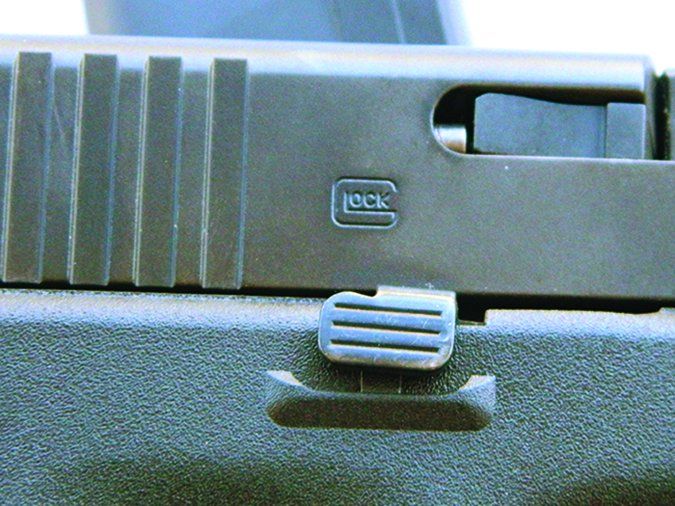
This was a recent price from SCGunco.com for a new G17. We chose the Glock Gen5 as a well-known baseline of firearm and cartridge against the more powerful handguns. For personal defense, when pitted against the 38 Super, the 9mm didn’t look that bad; but the 357 SIG outclasses the 9mm by 200 fps. We emphasize again that we did not compare average 9mm loads to the hottest load in other calibers, but rather the most capable in each caliber.
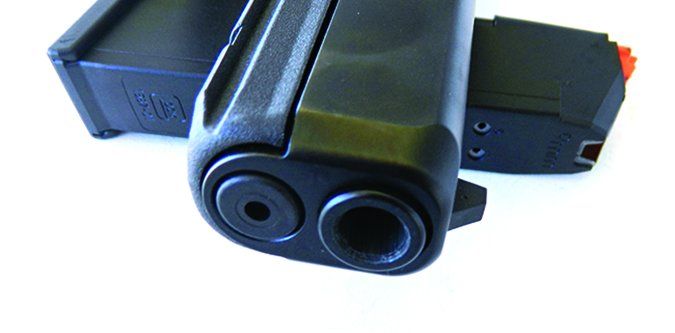
The Gen5 Glock features a modified trigger action that will not accept older aftermarket parts. The pistol features a true ambidextrous slide lock, a grip frame that fits most hands well, and a new-style flared magazine well that aids in rapid replenishment of ammunition. The orange-follower magazine holds 17 rounds and features a different basepad treatment compared to previous Glock pistols. The pistol’s barrel isn’t interchangeable with older Glocks and is rifled in the manner Glock terms as hexagonal rifling. The barrel also features a recessed barrel crown, uncommon in service pistols. The sights are only slightly different from previous Glock sights. They sat higher and the rear notch is wider. While the sight picture is improved, the taller front sight also resulted in the pistol firing low with most loads, about 1 inch to 1.5 inches low at 15 yards. The pistol is supplied with four slip-on grip inserts that are held in place by a single pin. It isn’t difficult at all to change the grip inserts. We used the pistol as issued for most testing, but in the end fitted a beavertail type insert, the thinnest issued. It seemed to aid control.
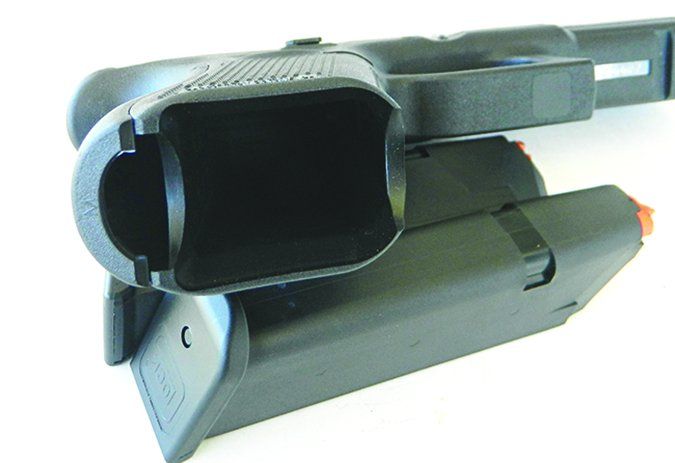
The incremental improvements, such as a coil spring replacing the flat spring on the take down catch, are appreciated but are not necessarily anything that would make us trade an older Glock for. On the other hand, a new Glock buyer should purchase this handgun rather than the older models, we believe. Another improvement we noted is the new tear-shaped striker. This avoids trapping debris in the firing pin channel. We have seen dirt and grit affect striker operation, and this area is generally overlooked in cleaning, so this is a good change.
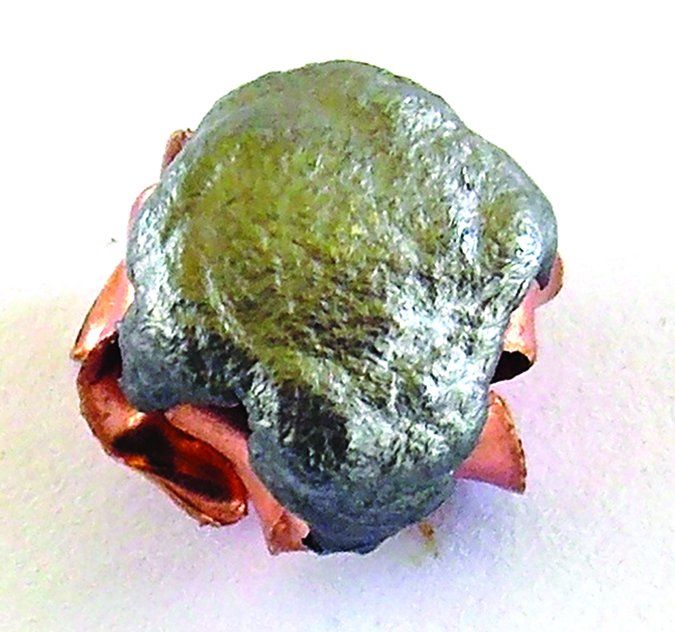
Ammunition tested in the Glock included DoubleTap 115-grain JHP +P rounds ($29/20 rounds at CheaperThanDirt.com), Hornady 124-grain +P American Gunner ($18.21/25 at CheaperThanDirt.com),
Federal 124-grain HST ammo ($23.97/50 at AmmunitionDepot.com), and Winchester 124-grain PDX +P rounds ($21.49/20 at MidwayUSA.com). In firing 100 rounds of CCI Blazer 115-grain FMJ loads during the combat course, the pistol did well in practical terms. Recoil is modest and control is good. The trigger broke at 5.5 pounds, standard for a Glock. In comparison, we thought the Springfield 1911 in 38 Super was superior on the combat course, with the XD in 357 SIG being about equal. In firing from the bench, the Glock 9mm performed well enough, but it was not outstanding, only slightly besting the Springfield XD. We failed to find an advantage in the new trigger action or barrel.
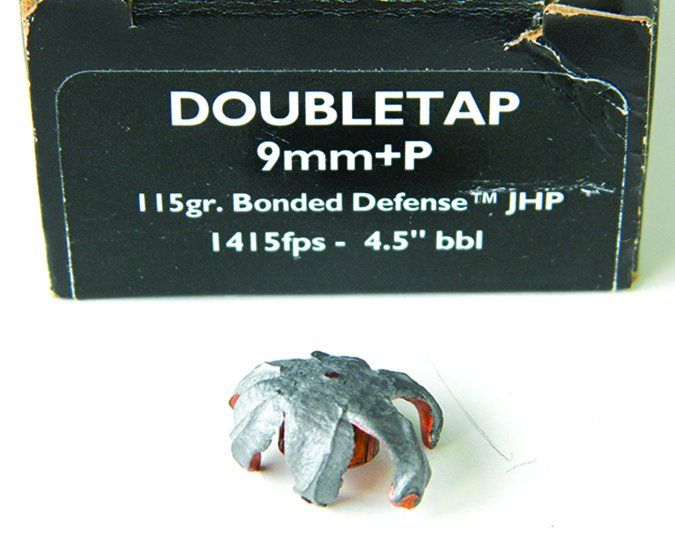
Our Team Said: The primary focus of the shoot out was to compare self-defense handguns and calibers, and the Glock 9mm is a better-than-average defensive firearm. In this case, however, we feel the good handling and power of the more powerful Springfield XD outclassed the Glock. The Glock is acceptable for personal defense, but would be behind the XD’s and Coonan’s curves for defense against feral dogs and big cats. In the 9mm Luger chambering, we would recommend the previously tested Vickers Tactical Glock 17 9mm Generation 4 ahead of the stock Gen5 Model 17.
Springfield Armory XD9113HCSP06 XD Service 4-inch 357 SIG, $250
GUN TESTS GRADE: A
The finish was well worn, but the used handgun worked well. One of the magazines turned out to have a problem; it failed to lock the slide open on the last shot. Function was faultless otherwise. This is a formidable handgun.
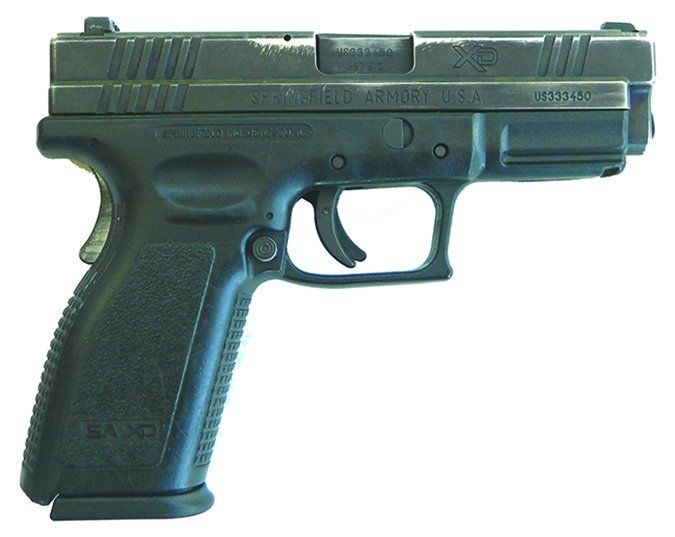
| ACTION | Locked breech single-action semi auto |
| OVERALL LENGTH | 7.3 in. |
| OVERALL HEIGHT | 5.5 in. |
| MAX WIDTH | 1.5 in. |
| WEIGHT UNLOADED | 30 oz. |
| WEIGHT LOADED | 35 oz. |
| MAGAZINE | (2) 12-rd. stainless steel |
| BARREL | 4 in. long; Melonite-treated steel, 1:16 twist; fully supported ramp |
| SLIDE | Blued |
| FRAME | Black polymer |
| FRAME FRONT STRAP HEIGHT | 2.3 in. |
| FRAME BACK STRAP HEIGHT | 3.5 in. |
| GRIPS | None |
| GRIP THICKNESS (max) | 1.3 in. |
| GRIP CIRCUMFERENCE (max) | 5.9 in. |
| SIGHTS | Dovetail front and rear night sights |
| SLIDE RETRACTION EFFORT | 11 lbs. |
| TRIGGER PULL WEIGHT (SA) | 6 lbs. |
| TRIGGER SPAN (SA) | 2.6 in. |
| SAFETY | Grip safety, firing pin block |
| WARRANTY | Lifetime |
| MADE IN | Geneseo, Illinois |
| TELEPHONE | (800) 680-6866 |
| WEBSITE | Springfield-Armory.com |
The company website says of this series, “The XD 4-inch Full Size is the original XD offering from Springfield Armory, and the most basic XD. This is the XD that started it all.” This is the price we paid for a used Springfield XD whose finish was worn on the slide. The model number listed above is for a night-sight-equipped 357 SIG XD that is no longer listed on the Springfield website. However, factory-new versions of this gun are available at retail. BudsGunShop.com recently listed this unit for $544.
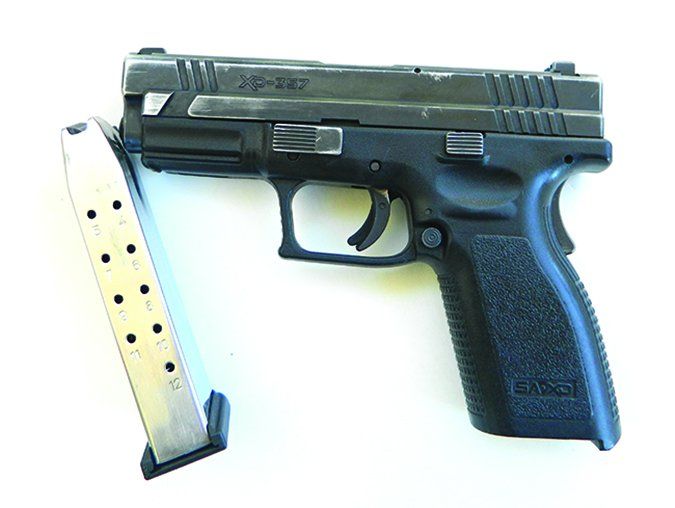
The very similar XD XD9103HC is listed on the Springfield website, and it has dovetailed front and rear steel three-dot sights, but was listed as “out of stock” at Bud’s. TombstoneTactical.com listed a price of $415 for the XD9103HC, but it was also out of stock.
Our test gun came with one 10-round and one 12-round magazine. We ordered a third magazine from SCGunco.com for $26.50. During testing, one of the used magazines fed well but failed to lock the slide to the rear and was removed from the test.
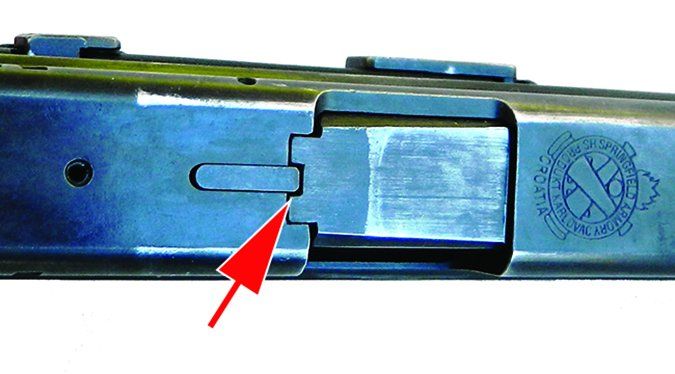
The Springfield features a hand-filling grip that accommodated most hands well. The grip safety prevents the pistol from being fired if it isn’t depressed and also locks the slide. The trigger breaks at a decent 6.0 pounds. A trigger lever set in the trigger face prevents lateral-pressure discharge. The sights are good examples of combat sights. While dim, the night sights were functional. This was the only pistol tested with night sights. Forward cocking serrations aided in racking the pistol. The XD features an ambidextrous magazine release, a loaded-chamber indicator, and a cocking indicator. Take down is the easiest of the pistols tested.
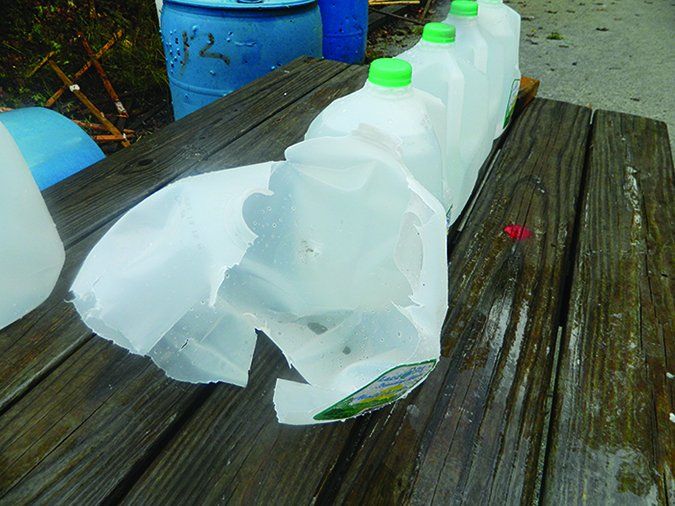
Overall, the XD is a good example of a modern striker-fired polymer-frame handgun. During the initial evaluation, we began firing the combat course with SIG Sauer Elite FMJ ammunition ($22.97/20 from CheaperThanDirt.com). We drew the pistol from James Nelson’s IWB neoprene-backed IWB holster (NelsonHolsters.com). The XD came on target quickly at 7, 10, and 15 yards. Combat accuracy was good. The pistol exhibited good control when firing DoubleTaps. There were no malfunctions, save the magazine’s failure to lock the slide back on the last shot, which was the result of a worn magazine. The XD exhibited greater recoil than the 9mm Glock or the 38 Super Springfield 1911, but it wasn’t uncomfortable to fire. Compared to the 9mm, however, firing strings were slower. You must practice good recoil control with this handgun or your combat results will be terrible. Once in rhythm, we had good results with the 357 SIG. Firing for accuracy at 25 yards, we used the DoubleTap 115-grain JHP ($27.38/20 from CheaperThanDirt.com), Winchester 125-grain SXTs ($21.95/20 at AmmoToGo.com), and Hornady’s 147-grain XTPs ($20/20 from SportsmansGuide.com). We added the 125-grain DoubleTaps for ballistic testing ($27.38/20 CheaperThanDirt.com). Though it was the least-accurate handgun tested, the XD was accurate enough for personal defense, with 25-yard groups of 2.4 to 2.9 inches for five shots from the Bullshooters rest (Brownells.com).
Our Team Said: The XD 357 SIG pistol is reliable and accurate enough for most chores and is the lightest handgun tested. When the excellent ballistics of the 357 SIG are figured in, this is a Best Buy handgun for carry or home defense.
Springfield Armory 1911 Mil-Spec 38 Super, $800
GUN TESTS GRADE: B
The Springfield had a lot going for it — reliability, good combat ability, and it is a 1911, which means it has a low bore axis and limited muzzle flip. However, the Springfield Mil-Spec 38 Super isn’t currently in production, and it is pricey.
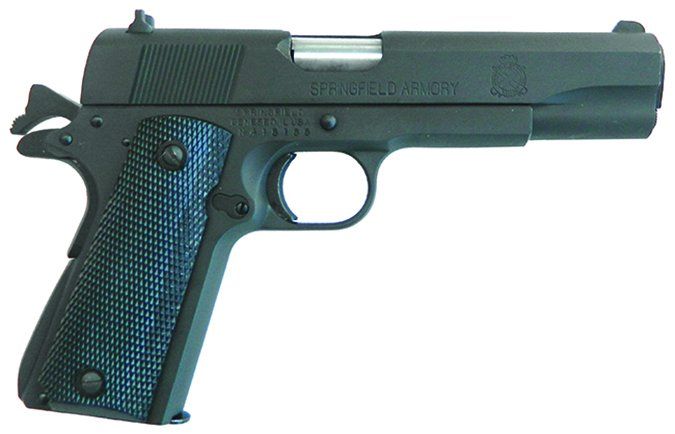
| ACTION | Locked breech single-action semi auto |
| OVERALL LENGTH | 8.5 in. |
| OVERALL HEIGHT | 5.4 in. |
| MAX WIDTH | 1.5 in. |
| WEIGHT UNLOADED | 39 oz. |
| WEIGHT LOADED | 43.5 oz. |
| BARREL | 5 in. long; steel, i:16 twist |
| MAGAZINE | 9-rd. detachable box |
| SLIDE | Parkerized steel |
| SLIDE RETRACTION EFFORT | 12 lbs. |
| FRAME | Parkerized steel |
| FRAME FRONT STRAP HEIGHT | 2.6 in. |
| FRAME BACK STRAP HEIGHT | 3.2 in. |
| GRIPS | Laser-engraved wood |
| GRIP THICKNESS (max) | 1.3 in. |
| GRIP CIRCUMFERENCE (max) | 5.4 in. |
| SIGHTS | Iron, fixed |
| TRIGGER PULL WEIGHT (SA) | 5 lbs. |
| TRIGGER SPAN (SA) | 2.5 in. |
| SAFETY | Slide lock safety, grip safety |
| WARRANTY | Lifetime |
| MADE IN | Geneseo, Illinois |
| TELEPHONE | (800) 680-6866 |
| WEBSITE | Springfield-Armory.com |
This handgun was produced in 1986 and at SCGunCo.com, it was new-in-the-box unfired. So, of course, we obtained and fired it. We added Mec-Gar magazines to round out the two supplied with the gun ($19.38 each from Brownells.com). The fit and finish of this Mil Spec handgun are good. The finish is evenly applied, and the dark checkered grips are a good match for the GI appearance. The sights are an improvement over the GI guns. So is trigger compression at a smooth 5.0 pounds even. The safety demonstrates a sharp indent. The pistol is a standard Government Model length 38 ACP Super pistol with a 5-inch ramped barrel. Initial evaluation was accomplished with the SIG Sauer 130-grain FMJ loading ($22.97/50 at AmmunitionDepot.com).
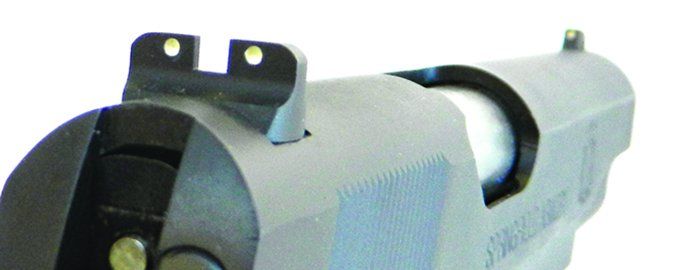
We experienced an odd malfunction, with the hammer falling but no marks on the primer. We wrote this off to the pistol being stored for many years, unfired, as it happened twice with the first magazine and did not repeat. However, the owner hedged his bets and replaced the firing-pin spring with an extra-power spring from Brownells ($31.95 for the extra-power function pack) to ensure the pistol functioned properly. The pistol exhibited the best trigger and the least felt recoil of any of the handguns. The pistol is fast on target and combat accuracy is good. DoubleTaps and speed drills provided excellent results. There is little muzzle flip due to the low bore axis of the 1911, and the steel-frame pistol was comfortable to fire.
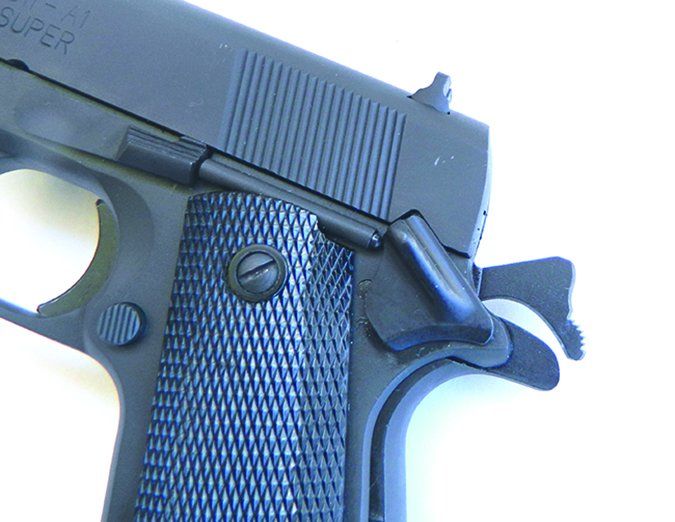
Reliability was faultless after the two odd FTF incidents. Ammunition for the 38 Super included Buffalo Bore 115-grain JHP ($28.79/20 from BuffaloBore.com), Buffalo Bore 147-grain JHP ($29.80/20 from BuffaloBore.com), DoubleTap 115-grain JHPs ($25.42/20 from DoubleTap.net, and DoubleTap 125-grain bonded JHPs ($25.42/20, also from DoubleTap.net).
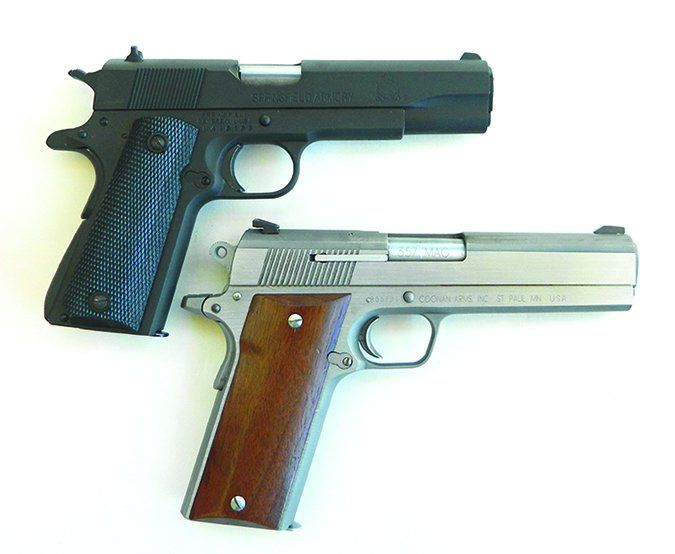
In bench-rest accuracy, the Springfield was accurate, but not quite as accurate as the Coonan. The best group was a tight 1.9 inches. The Mil-Spec proved faster to an accurate first shot than the other handguns and only slightly behind the Coonan in absolute accuracy. The Mil-Spec proved more accurate than a Rock Island 38 Super previously tested. While we consider the 38 Super to be an excellent defense cartridge with more power than the 9mm Luger, the 357 SIG outperformed the 38 Super in water ballistics. The 115-grain 357 SIG load was 97 fps faster than the 38 Super. The 125-grain load had a more modest advantage, at 37 fps faster. The 357 SIG 147-grain XTP load, however, was 99 fps faster than the 38 Super Buffalo Bore 147-grain load.
Our Team Said: Considering the 357 SIG has a greater magazine capacity and was fired in a pistol with a shorter barrel, we felt compelled to rank Springfield’s XD above its Mil-Spec. If you like the 1911 platform, the Springfield Mil-Spec is a formidable choice, but cartridge for cartridge, the shorter, but faster 357 SIG is the more powerful cartridge. If outdoors use is important, the extra velocity with the 147-grain bullet indicates the 357 has more utility and predicted effect. This answered several of our questions. Also, the Springfield Mil-Spec was much more expensive than the Springfield XD.
Coonan Classic 1911 100000-005 357 Magnum, $1200
GUN TESTS GRADE: A
At a $1200 counter price, this used Coonan provided the best accuracy and the greatest energy of the handguns tested. It was reliable, provided we used the proper loading technique.
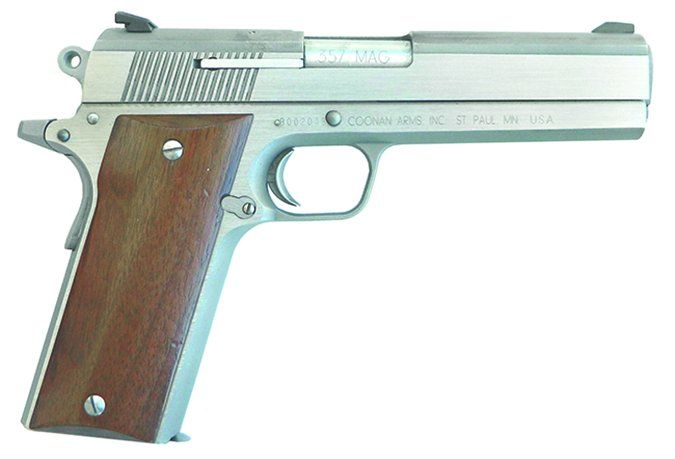
| ACTION | Locked breech, SA/DA, semi-auto |
| OVERALL LENGTH | 8.3 in. |
| OVERALL HEIGHT | 5.6 in. |
| MAX WIDTH | 1.3 in. |
| WEIGHT UNLOADED | 42 oz. |
| WEIGHT LOADED | 48 oz. |
| BARREL | 5 in. long; 4340 carbon steel, chrome plated; linkless |
| CAPACITY | 7+1 (single stack) |
| SLIDE | Brushed 17-4 PH stainless steel |
| FRAME | Brushed 17-4 PH stainless steel |
| FRAME FRONT STRAP HEIGHT | 2.9 in. |
| FRAME BACK STRAP HEIGHT | 3.5 in. |
| GRIPS | Black walnut, smooth |
| GRIP THICKNESS (max) | 1.3 in. |
| GRIP CIRCUMFERENCE (max) | 5.75 in. |
| SIGHTS | Fixed, 3 dot |
| SLIDE-RETRACTION EFFORT | 19 lbs. |
| TRIGGER PULL WEIGHT (SA) | 4 lbs. |
| TRIGGER SPAN (SA) | 2.9 in. |
| MAGAZINES | 2; steel |
| SAFETY | Thumb |
| WARRANTY | Lifetime |
| MADE IN | USA |
| WEBSITE | CoonanInc.com |
| STATE RESTRICTIONS | CA, MA |
None of the raters had previous experience with this big handgun. The Coonan is a 1911-style pistol very similar to other 1911s, but with important differences. The hammer, slide lock, slide-lock safety, and grip safety operate in the same manner as the 1911. The barrel doesn’t use a swinging link but instead uses angled camming surfaces. The trigger pivots like a Browning Hi-Power according to Coonan, but no Hi-Power trigger was ever this smooth. The extractor is an external type. The grip is longer than the Government Model 1911 due to the need to handle a magazine that holds seven 357 Magnum cartridges.
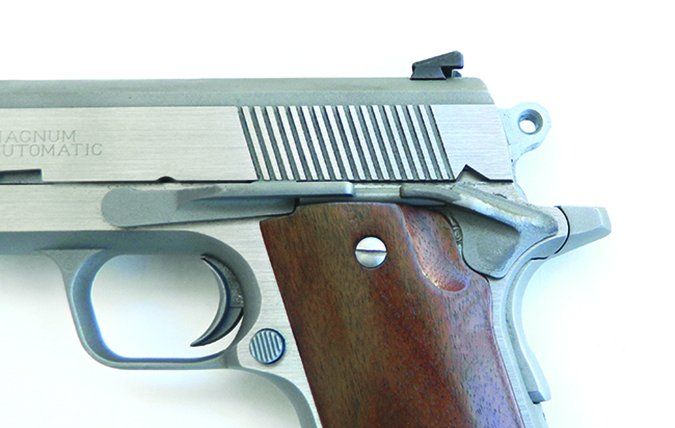
On this used gun, the trigger breaks at 5.1 pounds, and the sights are good, if not outstanding. Fit and finish of this stainless steel handgun are excellent. The barrel and slide are a monolithic type. The Coonan handled more quickly than we would have thought. The pistol balanced well and the heft is good. One rater likened the Coonan to a long-slide 1911 45 ACP. All controls, including the slide lock and magazine release, were crisp in operation.
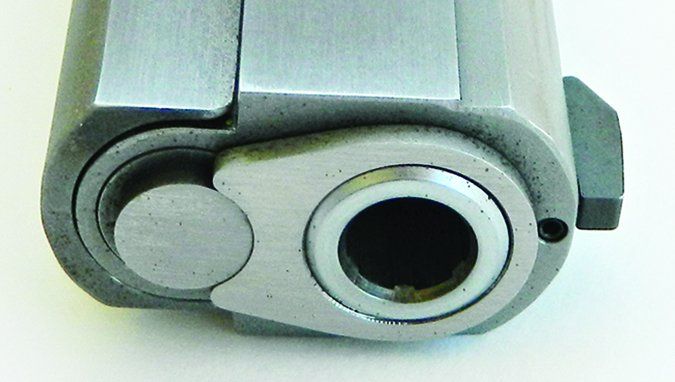
The Coonan was lubricated according to factory specifications prior to firing. It is important to properly lubricate the pistol and to load the magazines properly. The procedure is to load five cartridges and then angle the sixth and seventh cartridges in with the noses tipped upward, and then slip the cartridge to the rear, preserving the staggering of the cartridges necessary to feed a rimmed cartridge. If not properly loaded, when the magazine is tapped home with the slide locked to the rear, the top cartridge will fly out of the magazine and out the ejection port. Coonan advertises that this isn’t the gun for your first gun, and we agree. The pistol demands attention to detail from its owner. We never experienced a firing malfunction, but we did experience a shell being ejected from the top on loading, and it was the tester’s fault.
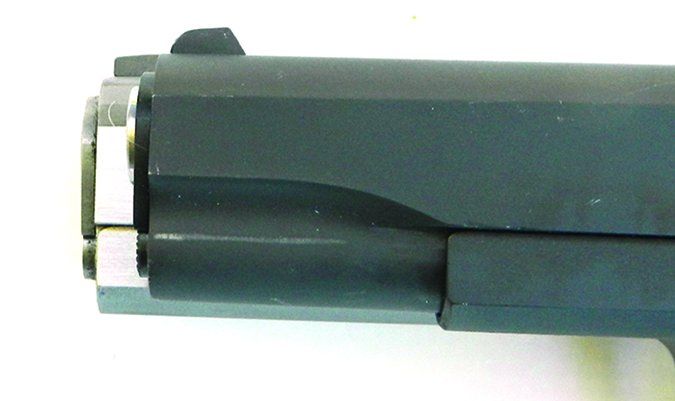
The pistol wasn’t the most pleasant of the handguns to fire. It is more comfortable than a 357 Magnum revolver, but there is plenty of recoil. We fired three loads for accuracy, the Federal 125-grain JHP ($24.72/ 20 from CheaperThanDirt.com), the Federal 140-grain Barnes ($30/20 rounds at LuckyGunner.com), the Federal 158-grain Hydra-Shok load ($13/20 at TargetSports.com), and added the DoubleTap 158-grain Bonded Core load for ballistic testing ($23.74/20 at DoubleTapAmmo.net). Initial firing on the combat range was accomplished with Fiocchi 158-grain JHPs, an affordable load ($23.75/50 from LuckyGunner.com). The pistol must be held in a solid grip. If you do not maintain this firm grip, your combat scores will be lousy. For those who practice, the pistol is controllable in rapid fire to an acceptable extent; however, the other handguns gave better combat scores. The philosophy is to get a hard first hit, recover, and get another, if needed, with the Coonan. You must learn how to balance this handgun. Splits between shots would have been slow, but you fire for accuracy and control recoil as the pistol resets its trigger. Fired from the bench rest, the pistol gave good results. Its most accurate group was a 1.25-inch five-shot group with the Federal 158-grain Hydra-Shok.
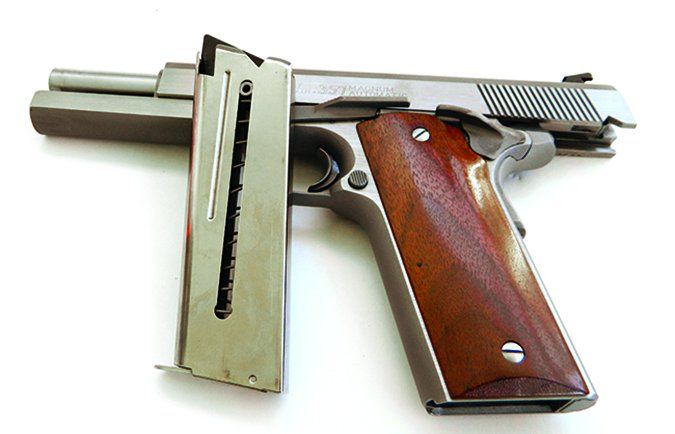
Our Team Said: The Coonan cost much more than the other handguns, but then it is unique. The pistol kicks the most of anything tested, but it is the most powerful. Spare magazines are $60 plus shipping. It certainly isn’t for the casual shooter. The Coonan would be a great outdoors handgun for defense against feral dogs and the big cats. We rated the pistol an A on all functional counts — it’s accurate, powerful, reliable. But the potential owner will have to gauge if it’s simply too much to haul around for every-day carry.
Cartridges: The Bottom Line
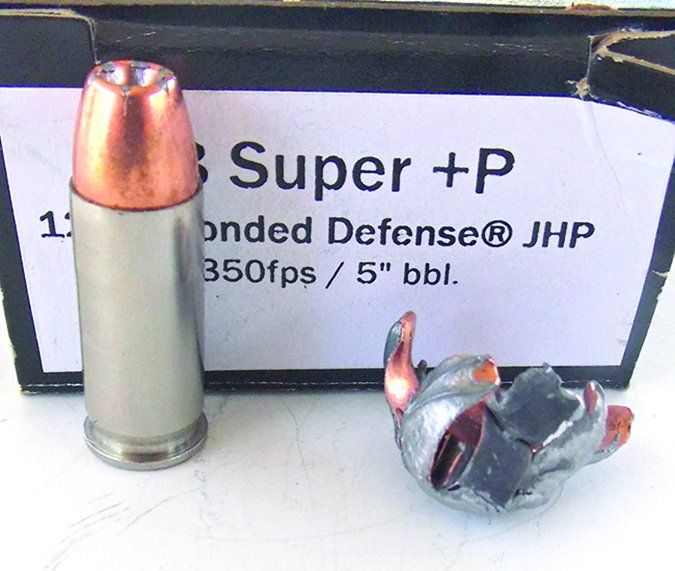
We learned the 9mm is okay as far as it goes, but it comes in a long way behind the best 38 Super and 357 SIG loads. The 9mm DoubleTap 1340 fps 115-grain load is impressive for personal defense, but the 38 Super at 1419 fps even more impressive.
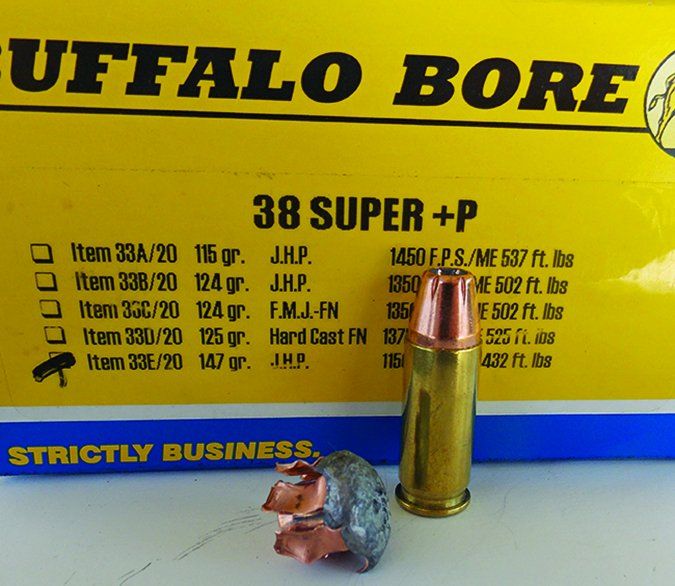
The penetration and expansion of the 115-grain 1519 fps 357 SIG load makes it a benchmark for personal defense in a compact handgun. The 357 SIG 125-grain DoubleTap load fragments early, and we felt it wasn’t the best choice for self defense. The 357 SIG Winchester PDX load is a credible load with modest recoil, good accuracy, and notable downrange performance. The Hornady 147-grain XTP is a great performer for those carrying the 357 SIG into the wild, with 24 inches of penetration and no fragmentation and 100% weight retention. Among the three standard pistol calibers, 9mm, 38 Super, and 357 SIG, the 357 SIG obviously holds the best cards, and as a bonus, the Springfield XD is light and concealable.
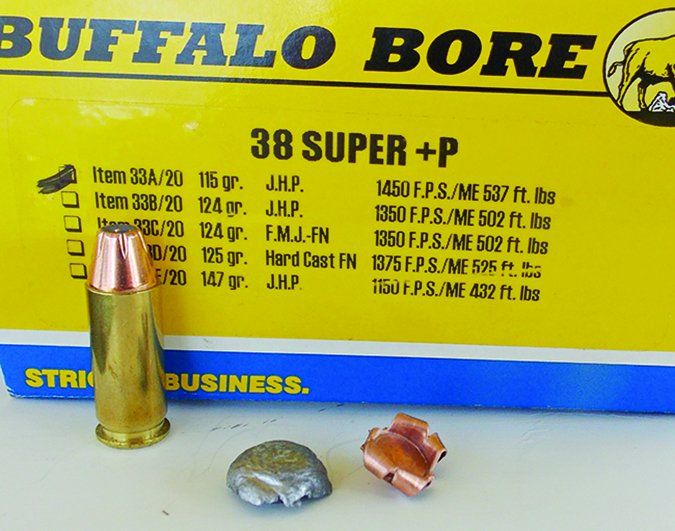
The 357 Magnum Coonan is another stratum. Ammunition performance was impressive and interesting. The Federal 125-grain load fragmented in 12 inches of water. We would have preferred the slower Buffalo Bore 38 Super loads to this load, but then a lot of energy was dumped in that foot of water. The Coonan generated 100 to 200 fps velocity increase over a 6-inch-barrel Taurus 357 Magnum revolver we had on hand for comparison, an important consideration.
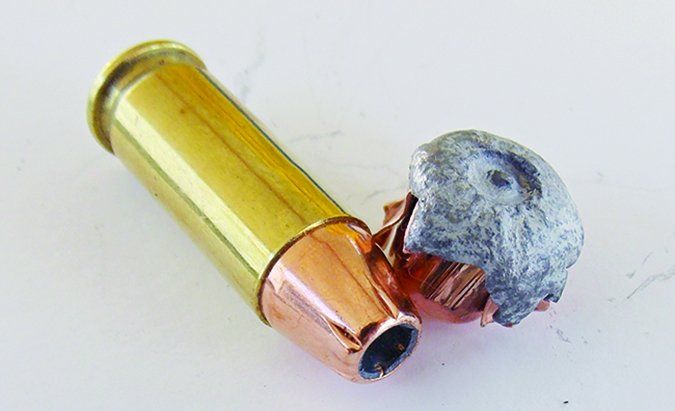
The Federal 140-grain Barnes load demonstrated excellent velocity and penetration, but failed to expand. Perhaps it would be better suited to a rifle. The Federal Hydra-Shok and DoubleTap bonded core 158-grain loads were neck and neck with 30 inches of penetration. These are excellent all-round outdoors loads with power and penetration for defense use.
Our Team Said: In the end, the 357 SIG gets the nod as a go-anywhere and do-anything handgun cartridge.
Written and photographed by Gun Tests Staff, using evaluations from Gun Tests team testers.



